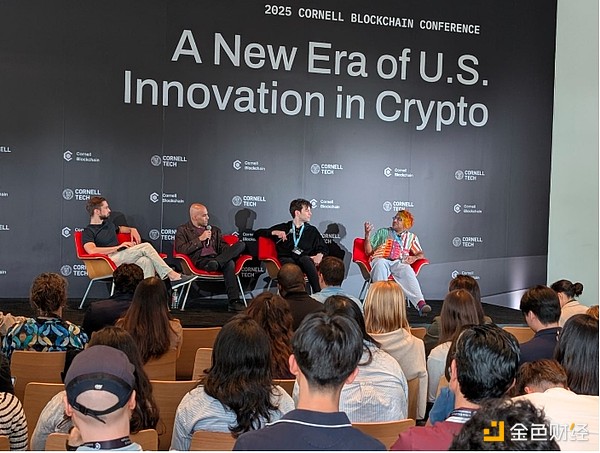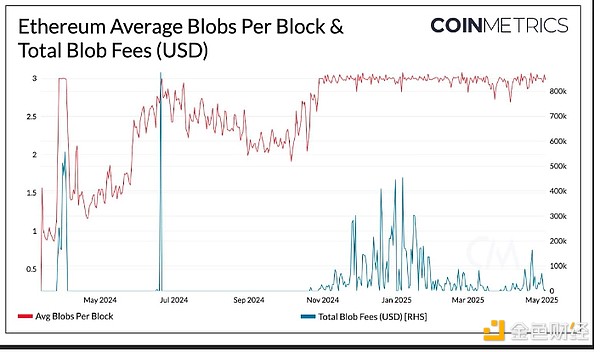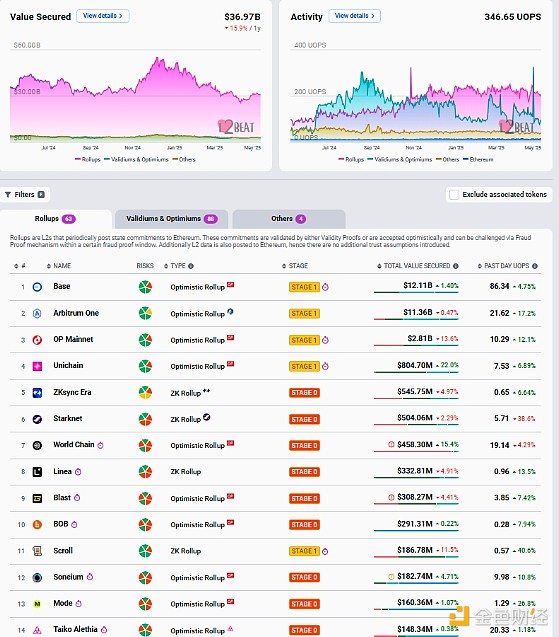Author: Andrew Singer, CoinTelegraph; Translated by Bai Shui, Jinse Finance
Layer 2 has always been a great success story in the blockchain field. They alleviate congestion on the Ethereum mainnet, reduce gas fees, while ensuring security.
But perhaps they have been too successful, to the point of drawing away a large amount of on-chain activity and fee income from their parent chain? At least some people think so, most recently at the Cornell Tech Blockchain Conference in late April.
In fact, some believe that Ethereum should be greedier, or at least work harder to capture a larger share of revenue, especially sequencing fees.
"People from the Ethereum Foundation (the non-profit supporting the Ethereum ecosystem) will tell you, 'Yes, we messed up by being too ivory tower.' I've heard this many times," said David Hoffman, boss of Bankless, during a panel discussion at the Cornell Tech event in New York on April 25.

Hoffman (left) attending the Cornell Tech Institute Blockchain Conference. Image source: Andrew Singer
Moreover, Hoffman urged Ethereum to undergo a "strategic transformation" and pointed out that the crypto environment has changed in recent years. Ethereum no longer enjoys the "luxury of a research project... being exploited by competitors".
James Beck, Growth Lead at ENS Labs and another speaker at the New York conference, stated that L2s are collecting millions of dollars in transaction ordering fees (sometimes called sequencing fees), but these revenues are not being transferred to Ethereum. Beck noted: "Well, compared to other tokens, the price of ETH has been declining. What can we do to make Ethereum stronger?"
In short, Ethereum is a neutral validation layer, but the Ethereum mainnet is not fairly compensated for its work. Centralized, for-profit L2s like Base, Optimism, and Arbitrum are collecting substantial sequencing fees while enjoying the security and activity guarantees of the Ethereum mainnet at a relatively low economic cost.
L2 Transaction Volume Surges After Dencun Upgrade
L2 Rollup is a recent innovation that emerged in 2023. Its original intention was to reduce blockchain congestion and gas fees by moving transaction processing from the main blockchain (Layer 1) to an independent chain above the mainnet (L2). However, transaction processing is undoubtedly the most profitable part of revenue distribution, especially when users choose to pay priority fees to speed up order processing.
Before Ethereum's Dencun upgrade in March 2024, fee sharing was hardly a major issue. The Dencun upgrade introduced blob transactions to help scale Layer 2. CoinMetrics researcher Tanay Ved pointed out this week that blob transactions significantly reduced the cost of L2 sending data to Ethereum, enabling more efficient operations.
Since then, L2 user demand has skyrocketed, especially on Base, launched by Coinbase on the Ethereum mainnet in August 2023.
As Ved noted in a blog post on April 8, Base generated approximately $98 million in revenue from user transaction fees (including base and priority fees), "while only paying about $4.9 million to the Ethereum base layer, so Base's estimated total profit since the Dencun upgrade is $94 million."
Ved added: This dynamic has led many to question whether Layer-2 is a net positive for Ethereum or has a "extractive" nature.
Base's Response
When asked about the fee issue, a Base spokesperson said: "Today, Base pays Ethereum fees for every transaction on the platform. All transactions are settled on Ethereum, and Base has paid over $20 million in settlement fees to Ethereum since its inception." The spokesperson added that you can view these fees under "Revenue Cost" on Token Terminal.
The spokesperson stated: "Overall, Base makes on-chain easier through fast and cheap transactions and helps develop the Ethereum ecosystem by attracting more users, developers, applications, and assets, all of whom use ETH for transactions and drive demand."
However, according to the cited Base financial statements, in many months (if not most), Base's total fees are approximately 10 times the transaction settlement fees paid to Ethereum. For example, in the most recent full month of April, Base earned $3.7 million in fees but only paid $305,000 as settlement fees to Ethereum, about 8% of total fees.
However, the situation may not be as bad as it seems. Others warn that even if fees are currently imbalanced, this imbalance may not continue. Ethereum hard forks, such as Pectra launched yesterday (May 7) and planned for Fusaka in late 2025, will increase blob throughput. "This means L2s will be able to publish more blobs, potentially driving up the total blob fees on the mainnet," Ved noted.
As shown in the following figure, Ethereum has steadily achieved the current goal of three blobs per block. Ved added: "Pectra will increase this number to 6 blobs per block, up to 9, creating space to increase fees as L2 activity expands."

Average number of blobs per block on Ethereum and total blob fees (USD). Source: CoinMetrics
Is a "Rollup-Based" Solution the Answer?
Some Ethereum researchers, podcasters, and even L2 chain developers tend to view "rollup-based" as a more sustainable solution to address fee issues and provide better security. In this case, transaction sequencing would be completed on the mainnet, not on the L2 chain.
Some researchers say that sequencers used by Optimism, Arbitrum One, Base, and others are more vulnerable to attacks or failures because they are centralized with single points of failure. Polygon's Jarrod Ward wrote:
If a centralized sequencer fails, the rollup will essentially stop working completely. It will stop processing transactions from users on the L2 chain and stop sending batch data back to Ethereum.
"Layer-2 sequencers have become very centralized, very dangerous," added Tom Ngo, Executive Director at Metis (an Ethereum Layer-2 blockchain).
Last June, when the Layer 2 blockchain Linea was hacked, losing $2.6 million, this deeply impressed Ngo and others about the importance of decentralization and the dangers of centralized sequencers.
Several rollup-based L2 projects went online last year. Taiko Alethia, the first and largest project, launched in May 2024. A year later, its total value locked reached $148.3 million, ranking 14th on the L2Beat L2 project list, but far behind the leader Base at $12.06 billion.

Ranking of Ethereum Layer 2 tokens by total value locked. Source: L2Beat
In terms of speed, Taiko reached a considerable 20.3 user operations per second (UOPS) on May 7, far from Base's 86.3 UOPS, but comparable to Arbitrum One's 21.6 UOPS and significantly better than Optimism's 10.3 UOPS.
Taxing L2?
Another idea in the Ethereum community is to tax L2s. But Ved says this could have some unintended consequences. It could reduce L2's competitiveness. It could also lead to "activity leaking to competing Layer 1s outside the Ethereum ecosystem". Ved says the activity currently flowing to Base might flow to Solana or other Layer 1s.
Taxing L2s might also present some philosophical issues. Ved noted:
Taxation might contradict Ethereum's decentralization philosophy, which tends to be market-driven rather than forced taxation.
Ved explained that overall, the Ethereum Foundation seems to prioritize long-term growth over short-term income. However, proposals like EIP-7762, which increase the minimum blob base fee to accelerate price discovery during demand surges, could potentially generate more fee income for the Ethereum mainnet, creating a tax-like effect.
Social Pressure?
According to Beck from ENS Labs, some social pressure might be needed to encourage leading centralized Layer 2 solutions to voluntarily give up their sequencing fees. Other Layer 2 solutions like Linea might need to intervene and make statements like: "Look, these risks exist in more centralized designs, and now is the time to integrate [order processing] into a more decentralized Ethereum."
To this end, ENS participated in a three-day workshop in the UK in January, with top researchers and developers from entities like Linea, Status, OpenZeppelin, Titan, Spire Labs, and the Ethereum Foundation. The priority was how to create scalable decentralized infrastructure for ENS Labs' Namechain and how to gather Ethereum ecosystem teams to collectively address Layer 1 and Rollup-based interoperability challenges.
Beck acknowledged that completing work in a flat, multi-participant entity like Ethereum is not easy. "Ethereum is a decentralized ecosystem. You can't make everyone reach consensus simultaneously." But collaborations like the recent one in the UK are a start.
Hoffman from the Cornell Tech conference group expressed confidence that Ethereum can transform and "turn Layer 1 into a Rollup" with processing speeds comparable to today's Layer 2 solutions.
As mentioned earlier, Hoffman had criticized the Ethereum Foundation for being too closed and academic, but he saw signs that things might be changing, recently writing:
The joint executive director appointment of Tomasz Stańczak and Hsiao-Wei Wang marks the arrival of a new era of accountability, direction, and internal cohesion.
"I feel optimistic," Beck added. "Ethereum still has the most DeFi locked assets; most stablecoins are also on Ethereum. BlackRock has a fund settling on Ethereum."
In other words, Ethereum still has the capability to provide infrastructure for the "network of networks" - a smoothly interacting network comprising numerous private and public chains, which many hope will be the technology's future.







